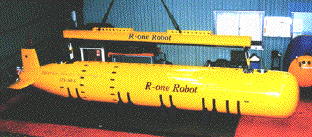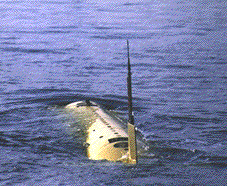
(Photos: Mitsui Engineering and Shipbuilding Co.)
UNDERSEA EXPLORATION:
Next-Generation Robot Developed
NOVEMBER 22, 1996

(Photos: Mitsui Engineering and Shipbuilding Co.)
New Exhaust-Free Design
A next-generation undersea exploratory robot, able to dive as deep as 400 meters and operate on its own power for as long as 24 hours, has made its appearance. Developed jointly by the University of Tokyo's Institute of Industrial Science and a private shipbuilding firm, the robot is propelled by a diesel engine. It is said to be the first free-operating undersea exploratory robot not to run on batteries. Compared to scientific investigations carried out from the surface of the ocean, those using this robot will be able to detect changes in the ocean with greatly increased precision.

(Photos: Mitsui Engineering and Shipbuilding Co.)
The cylindrical robot measures 8.3 meters in length and 1.2 meters in width, and reaches a top speed of 3.6 knots. Its main feature is the newly designed propulsion system, a motor powered by electricity generated by the robot's diesel engine. The engine itself is a completely closed system that needs no intake of air to run and chemically processes exhaust gas inside the robot. On-board devices reinfuse the exhaust with oxygen after removing its carbon dioxide and reuse the gas in the fuel mixture. The seawater is kept clean, as no gas is released.
As the robot's movements are programmed before its dive, there is no need to guide its operations by remote control. The robot constantly calculates its position with an inertial navigation system like that of an airplane and can tell its depth by measuring water pressure. This function has proved accurate to within 10 centimeters at a depth of 150 meters in testing so far.
Instruments aboard the robot take quick measurements of the seawater's oxygen content, salinity, temperature, and pH value at four-second intervals, or about every five meters. The robot can also be equipped with instruments to measure magnetic fields and metal concentrations in the water, and otherwise investigate the oceanic environment.
There are around 20 non-tethered undersea exploratory robots in the world, but they are of limited utility as they all run on expensive silver-zinc power cells that can be recharged no more than 50 times or so before they become useless. The newly developed robot, on the other hand, runs on a modified diesel engine, which both decreases the cost of operation and increases the useful lifetime of the machine.
Japan's Successful Deep-Sea Exploration Program
In the field of Japanese oceanography, deep-sea expeditions are regarded as especially advanced. In March 1995, the Marine Science and Technology Center, affiliated with the Science and Technology Agency, sent its "Kaiko" unmanned deep-sea probe to a depth of 10,911 meters in the Mariana Trench, off the coast of Guam. And in August 1989, the manned probe "Shinkai 6500" successfully reached a depth of 6,527 meters. These are the deepest-operating manned and unmanned probes currently in commission.
Both of these probes are equipped to obtain specimens of rock and detritus from the sea floor, and can thus increase our understanding of ancient geology and deep-sea biology. Both probes, however, require from two-and-a-half to three hours to reach their operating depths. Furthermore, the "Kaiko" probe is connected to a surface ship via a communications cable, and the "Shinkai 6500" has a limited time that it can stay underwater. Neither, therefore, is appropriate for extended oceanographic surveys, both having an operating radius of only 200 meters or so. The newly designed robot is expected to be able to perform farther-ranging survey activities in shallower depths.